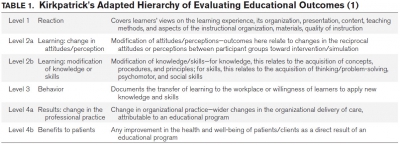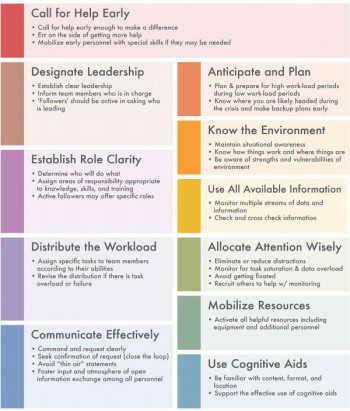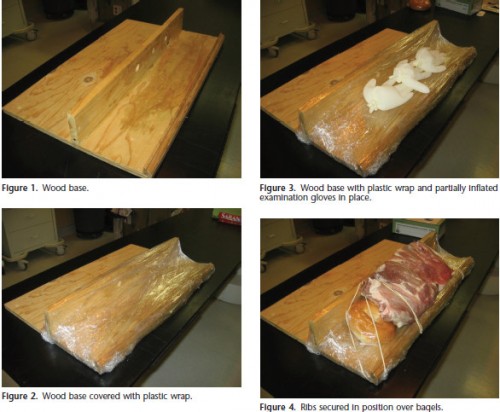12/03/2015
Simulateur de crico: Pas cher, c'est possible
Every Surgical Resident Should Know How to Perform a Cricothyrotomy: An Inexpensive Cricothyrotomy Task Trainer for Teaching and Assessing Surgical Trainees.
Aho JM et Al. J Surg Educ. 2015 Feb 18. pii: S1931-7204(14)00346-8
OBJECTIVE:
Emergency cricothyrotomy is a rare but potentially lifesaving procedure. Training opportunities for surgical residents to learn this skill are limited, and many graduating residents have never performed one during their training. We aimed to develop and validate a novel and inexpensive cricothyrotomy task trainer that can be constructed from household items.
DESIGN:
A model was constructed using a toilet paper roll (trachea and larynx), Styrofoam (soft tissue), cardboard (thyroid cartilage), zip tie (cricoid), and fabric (skin). Participants were asked to complete a simulated cricothyrotomy procedure using the model. They were then evaluated using a 10-point checklist (5 points total) devised by 6 general surgeons. Participants were also asked to complete an anonymous survey rating the educational value and the degree of enjoyment regarding the model.

SETTING:
A tertiary care teaching hospital.
PARTICIPANTS:
A total of 54 students and general surgery residents (11 medical students, 32 interns, and 11 postgraduate year 3 residents).
RESULTS:
All 54 participants completed the training and assessment. The scores ranged from 0 to 5. The mean (range) scores were 1.8 (1-4) for medical students, 3.5 (1-5) for junior residents, and 4.9 (4-5) for senior-level residents. Medical students were significantly outperformed by junior- and senior-level residents (p < 0.001). Trainees felt that the model was educational (4.5) and enjoyable (4.0).
CONCLUSIONS:
A low-fidelity, low-cost cricothyrotomy simulator distinguished the performance of emergency cricothyrotomy between medical students and junior- and senior-level general surgery residents. This task trainer may be ideally suited to providing basic skills to all physicians in training, especially in settings with limited resources and clinical opportunities.
| Tags : coniotomie, matériel
20/12/2014
Simulation: Oui bien sûr, mais ?
The Role of Simulation in Continuing Medical Education for Acute Care Physicians: A Systematic Review
Khanduja PK et Al. Crit Care Med. 2015 Jan;43(1):186-93.
-------------------------------------------------------------------
Une revue de littérature qui pointe le caractère positif RESSENTI par les participants à un programme de formation continue par simulation. Cette revue de littérature peine à confirmer que ce ressenti se traduit par une réelle amélioration de la prise en charge de nos patients. Les auteurs ne retrouvent en effet qu'une seule étude atteignant les stades 4a et b de Kirkpatrick, c'est à dire des niveaux où sont observés des changements de pratique et un bénéfice objectif pour les patients. Une des difficultés tient au fait que nombre de travaux portent sur l'anesthésie et tout particulièrement en milieu universitaire. Ils concluent néanmoins à l'intérêt de cette méthode d'enseignement.
-------------------------------------------------------------------
OBJECTIVES:
We systematically reviewed the effectiveness of simulation-based education, targeting independently practicing qualified physicians inacute care specialties. We also describe how simulation is used for performance assessment in this population.
DATA SOURCES:
Data source included: DataMEDLINE, Embase, Cochrane Database of Systematic Reviews, Cochrane CENTRAL Database of Controlled Trials, and National Health Service Economic Evaluation Database. The last date of search was January 31, 2013.
STUDY SELECTION:
All original research describing simulation-based education for independently practicing physicians in anesthesiology, criticalcare, and emergency medicine was reviewed.
DATA EXTRACTION:
Data analysis was performed in duplicate with further review by a third author in cases of disagreement until consensus was reached. Data extraction was focused on effectiveness according to Kirkpatrick's model. For simulation-based performance assessment, tool characteristics and sources of validity evidence were also collated.
DATA SYNTHESIS:
Of 39 studies identified, 30 studies focused on the effectiveness of simulation-based education and nine studies evaluated the validity of simulation-based assessment. Thirteen studies (30%) targeted the lower levels of Kirkpatrick's hierarchy with reliance on self-reporting.

CONCLUSIONS:
Simulation is perceived as a positive learning experience with limited evidence to support improved learning. Future research should focus on the optimal modality and frequency of exposure, quality of assessment tools and on the impact of simulation-based education beyond the individuals toward improved patient care.
15/04/2014
Analyse cognitive de tâche: Une nécessité pour l'enseignant
The Effectiveness of a Cognitive Task Analysis Informed Curriculum to Increase Self-Efficacy and Improve Performance for an Open Cricothyrotomy
Campbell J et All. J Surg Educ. 2011 Sep-Oct;68(5):403-7.
Un des enjeux de l'apprentissage d'un geste technique est de reproduire la séquence nécessaire tele que décrite par un expert. Hors il est démontré que près de la moitié des phases nécessaires ne sont pas décrites par ces derniers. L'analyse cognitive de tâche est une technique visant à identifier toutes ces phases réalisées de manière inconsciente par les experts qui dès lors de les décrivent pas. La référence proposée porte sur la coniotomie, mais toute activité technique est concernée.
OBJECTIVE: This study explored the effects of a cognitive task analysis (CTA)-informed curriculum to increase surgical skills cothyrotomy, procedural skills, surgical skills, curriculum performance and self-efficacy beliefs for medical students and development postgraduate surgical residents learning how to perform an open cricothyrotomy.
METHODS: Third-year medical students and postgraduate year 2 and 3 surgery residents were assigned randomly to either the CTA group (n ϭ 12) or the control group (n ϭ 14). The CTA group learned the open cricothyrotomy procedure using the CTA curriculum. The control group received the traditional curriculum.
RESULTS: The CTA group outperformed the control group significantly based on a 19-point checklist score (CTA mean score: 17.75, standard deviation [SD] ϭ 2.34; control mean score: 15.14, SD ϭ 2.48; p ϭ 0.006). The CTA group also reported significantly higher self-efficacy scores based on a 140- point self-appraisal inventory (CTA mean score: 126.10, SD ϭ 16.90; control: 110.67, SD ϭ 16.8; p ϭ 0.029).
CONCLUSIONS: The CTA curriculum was effective in increasing the performance and self-efficacy scores for postgraduate surgical residents and medical students performing an open cricothyrotomy.
07/12/2013
Un modèle de formation hybride ?: A méditer
Evaluation of a training curriculum for prehospital trauma ultrasound.
Press GM et Al. The Journal of Emergency Medicine, Vol. 45, No. 6, pp. 856–864, 2013
BACKGROUND:
In the United States, ultrasound has rarely been incorporated into prehospital care, and scant descriptions of the processes used to train prehospital providers are available.
OBJECTIVES:
Our objective was to evaluate the effectiveness of an extended focused assessment with sonography for trauma (EFAST) training curriculum that incorporated multiple educational modalities. We also aimed to determine if certain demographic factors predicted successful completion.
METHODS:
All aeromedical prehospital providers (APPs) for a Level I trauma center took a 25-question computer-based test to ascertain baseline knowledge. Questions were categorized by content and format. Training over a 2-month period included a didactic course, a hands-on training session, proctored scanning sessions in the Emergency Department, six Internet-based training modules, pocket flashcards, a review session, and remedial training. At the conclusion of the training curriculum, the same test and an objective structured clinical examination were administered to evaluate knowledge gained.
RESULTS:
Thirty-three of 34 APPs completed training. The overall pre-test and post-test means and all content and format subsets showed significant improvement (p < 0.0001 for all). No APP passed the pre-test, and 28 of 33 passed the post-test with a mean score of 78%. No demographic variable predicted passing the post-test. Twenty-seven of 33 APPs passed the objective structured clinical examination, and the only predictive variable was passing the post-test (odds ratio 1.21, 95% confidence interval 1.00-1.25, p = 0.045).
CONCLUSION:
The implementation of a multifaceted EFAST prehospital training program is feasible. Significant improvement in overall and subset testing scores suggests that the test instrument was internally consistent and sufficiently sensitive to capture knowledge gained as a result of the training. Demographic variables were not predictive of test success.
02/12/2013
Maîtrise des VAS: Simuler il en restera quelque chose
Advanced Airway Management Simulation Training in Medical Education: A Systematic Review and Meta-Analysis
Kennedy CC et All. Crit Care Med 2013; 41:00–00
Les quelques lignes qui suivent sont d'une importance cruciale pour la mise en oeuvre d'une politique de formation à la maîtrise des voies aériennes et le maintien de ces compétences. On ne peut être que surpris par l'intérêt modéré de la pratique au bloc opératoire versus la simulation.
------------------------------------------------------------------------
Educators face many choices when designing a curricula—whether to use lecture, video, web-based teaching, and/or simulation. Our findings have substantial implications for educators and researchers. First, educators designing airway education courses can be confident that simulation is effective in comparison with no intervention for most measured outcomes. It also appears to be more effective than non simulation education (e.g., video, lecture, self-study, and OR training) for many educational outcomes. Second, simulation was associated with higher learner satisfaction compared with nonsimulation interventions. Educators designing simulation curricula face further choices, such as which model(s) to use, how to ensure learners retain the skills, and how to provide feedback. This review begins to answer such questions. Learner satisfaction increased with biologic models. Such preferences may be important in designing curriculum, although evidence is presently lacking with regard to the impact on other learning outcomes. Formal training in the OR in addition to simulation training was not associated with benefit. Although evidence is limited, this finding is of considerable practical import given the substantial commitment by OR personnel and potential safety risks incurred by such training. Addition of standardized patients to airway management training likewise does not appear to be beneficial. Finally, curricula that include course repetition, ongoing practice with or without evaluation with feedback, and use of self-regulated learning appear effective in airway management skill retention and should be incorporated for those requiring skills maintenance.
18/10/2013
Simulation: Et le modèle animal ?
Use of Animals by NATO Countries in Military Medical Training Exercises: An International Survey
Gala SG et all. Military Medicine, 177, 8:907, 2012
La formation de nos personnels au sauvetage au combat fait appel de multiples ressources pédagogiques. Le recours à des mannequins plus ou moins sophistiqués est de plus en plus courant. Le modèle animal est toujours d'actualité bien que de plus en plus décrié et encadré. Cet article fait le point sur le recours à un tel modèle par les armées de l'OTAN.
| Tags : pédagogie
09/10/2013
Aide cognitive: Pour gérer une situation de crise
Gérer une situation de crise ne s'improvise pas (CRM: Crisis ressources management). Ceci nécessite la mise en oeuvre de ressources complexes parfaitement décrite dans la figure qui suit et qui doit être bien comprise pour la mise en oeuvre d'un poste de secours.
L'université de Stanford fait la promotion de l'emploi de telles aides accessibles sur ce lien. De telles aides sont également proposées par la SFAR. On peut estimer que la fiche RSA peut être assimilé à une aide cognitive pre et post management CRM.
14/09/2013
Réalité augmentée et sauvetage au combat: Bientôt ?
Using augmented reality as a clinical support tool to assist combat medics in the treatment of tension pneumothoraces.
Wilson KL et All. Mil Med 2013; 178(9):981-5
----------------------------------------------------------------------------------------
La réalité augmentée désigne les systèmes informatiques qui rendent possible la superposition d'un modèle virtuel 3D ou 2D à la perception que nous avons naturellement de la réalité et ceci en temps réel. La commercialisation récente des Google glass est le témoin d'une technologie qui devient mature. Dès lors il n'est pas étonnant qu'un tel dispositif soit utilisé dans les domaines de la formation voire en conditions réelles. Le travail présenté ci-après n'est qu'un exemple.
----------------------------------------------------------------------------------------
This study was to extrapolate potential roles of augmented reality goggles as a clinical support tool assisting in the reduction of preventable causes of death on the battlefield. Our pilot study was designed to improve medic performance in accurately placing a large bore catheter to release tension pneumothorax (prehospital setting) while using augmented reality goggles. Thirty-four preclinical medical students recruited from Morehouse School of Medicine performed needle decompressions on human cadaver models after hearing a brief training lecture on tension pneumothorax management. Clinical vignettes identifying cadavers as having life-threatening tension pneumothoraces as a consequence of improvised explosive device attacks were used. Study group (n = 13) performed needle decompression using augmented reality goggles whereas the control group (n = 21) relied solely on memory from the lecture. The two groups were compared according to their ability to accurately complete the steps required to decompress a tension pneumothorax. The medical students using augmented reality goggle support were able to treat the tension pneumothorax on the human cadaver models more accurately than the students relying on their memory (p < 0.008). Although the augmented reality group required more time to complete the needle decompression intervention (p = 0.0684), this did not reach statistical significance.
| Tags : pédagogie, simulateurs
27/06/2013
DU Fosei
A partir de la rentrée universitaire 2013 et dans le cadre du projet SAMSEI , l'université de médecine proposera une formation à la simulation. Fidèle au principe d'enseignement par ilmmersion ce DU est conduit avec l'ensemble des structures universitaires lyonnaises mais aussi le service de santé des armées notamment le CITERA de l'HIA Desgenettes, Le Cefos et l'Institut de recherche du SSA.
Les modalités pratiques d'inscription à ce DU sont disponibles sur ce lien.
| Tags : simulateurs
24/06/2013
Simulateur de geste: Pour drainer le thorax
11/12/2011
Quel modèle pour apprendre la coniotomie ?
L'apprentissage de ce geste est fondamental et fait appel le plus souvent à des simulateurs dont l'inconvénient est le coût élevé des pièces de rechange. Un des plus performants est le TraumaMan relativement onéreux. Des simulateurs moins performants existent (1, 2, 3, 4, 5). Certains ont développé des systèmes artisanaux plus ou moins sophistiqués qui n'ont pas cet inconvénient (6, 7, 8). Ces derniers permettraient un apprentissage de qualité identique à des modèles sophistiqués. Les modèles animaux ne seraient pas tous appropriés notamment le modèle canin, ce qui semble être moins vrai avec un modèle porcin. L'apprentissage exclusif sur cadavre est difficilement envisageable. La meilleure approche est certainement d'acquérir cette compétence d'abord sur mannequins et de finaliser par l'apprentissage sur cadavre. 5 gestes réussis semblent être requis.
| Tags : simulateurs, pédagogie




